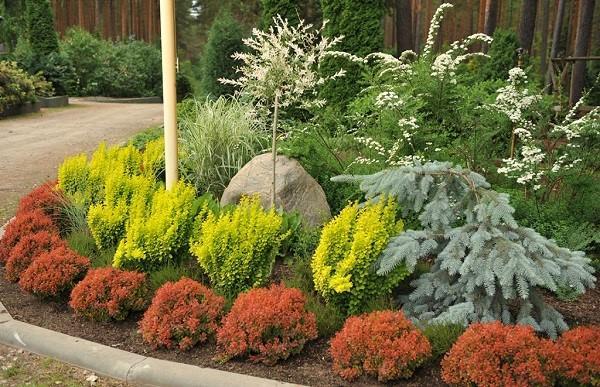Barberry Thunberg in landscape design - ways to use
 Variegated types of barberry are widely used for decorative design of personal plots. One of them is the Thunberg barberry and its varieties. This plant is native to mountainous, rocky areas and grows well in almost all conditions.
Variegated types of barberry are widely used for decorative design of personal plots. One of them is the Thunberg barberry and its varieties. This plant is native to mountainous, rocky areas and grows well in almost all conditions.
How to use an evergreen shrub in your site design?
Barberry Thunberg you can land on the site in one of the following ways:
- single landings;
- group plantings;
- rocky hills;
- shrub mixborders;
- Japanese gardens;
- curbs and hedges.
Single and group landings
For single plantings, species with a rich, bright leaf color are suitable. A yellow or crimson bush, even in the singular, will stand out favorably on the site and focus on itself, which is very convenient if you need to hide some unsightly ledge or corner.
For group plantings, it is better to use two types of barberry, different in height and leaf color. For example, plant a shrub with yellow leaves in the background, and under it - undersized crimson barberries.
The combination looks good barberry shrub (photo) with other tall plantings in the center, for example, thuja surrounded by multi-colored varieties of barberry. The advantage of such a composition is also that it is clearly visible from all sides.
Slides and mixborders
Rocky slides are just perfect for a mountain perennial, as they allow it to create almost natural conditions.
For alpine slides, it is better to use low-growing varieties of barberry with a height of no more than 40 cm.
Barberry grows well along buildings or a fence as a shrub mixborder and goes well with conifers, especially if you choose a contrasting design:
- background - dark-colored evergreen juniper or thuja;
- foreground - bright yellow medium-sized barberries.
Japanese gardens. Low barberry bushes such as Green Carpet blend perfectly with pillow-like azaleas and eventually cover the soil with a carpet. The taller barberry can also be used if it is trimmed regularly.
Curbs and hedges
Low dense bushes (Admiration grade) are used for low curbs. Planting bushes should be carried out at a distance of 25-30 cm from each other. To create a taller hedge (up to 80 cm in height), the barberry Maria is more suitable. Its shoots are covered with small thorns, which will make the fence impassable and save you from installing additional fences at the border of the site.